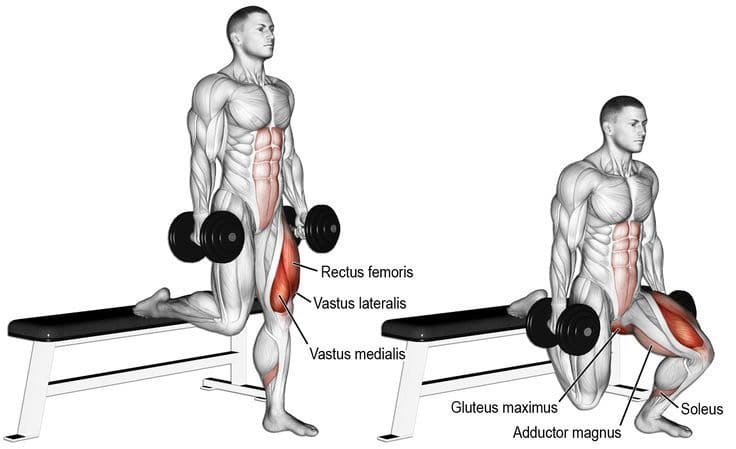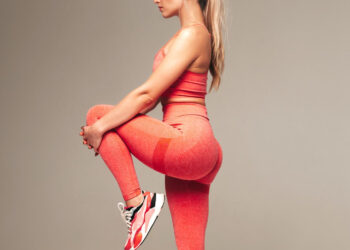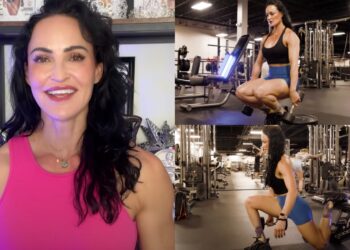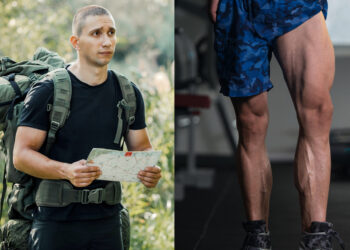Discover why Bulgarian split squats (BSS) are superior to leg extensions and learn about their advantages over leg extensions for building lower body strength and stability.
As a veteran personal trainer with seven years in the trenches, I can vouch that most people join the gym with preconceived notions that are usually influenced by hearsay and anecdotal evidence. For example, some hail the barbell bicep curl as the greatest exercise ever created and squats as the worst.
This love-hate relationship with squats persists until I introduce them to Bulgarian split squats. Then, many quickly dub BSS the most challenging exercise of all. This exercise involves performing lunges with one foot planted on an elevated surface 2-3 feet behind you.
Leg extensions are the go-to for many exercisers on leg days. However, sticking to just isolation movements can do more harm than good. Compound unilateral exercises like Bulgarian split squats can help improve strength and balance and effectively target your quads, glutes, and hamstrings.
Benefits of Bulgarian Split Squats Over Leg Extensions
Here are the advantages of Bulgarian split squats over leg extensions:
Functional Strength
Whether you are a hobbyist trainer or an elite athlete, Bulgarian split squats can boost your overall functionality. This compound exercise builds strength that translates to real-world function and overall athleticism.
Level Up Your Fitness: Join our 💪 strong community in Fitness Volt Newsletter. Get daily inspiration, expert-backed workouts, nutrition tips, the latest in strength sports, and the support you need to reach your goals. Subscribe for free!
Improves Balance and Stability
Conventional lunges are cute, but the game is flipped on its head when you must perform the same movement with one leg elevated behind you. Suddenly, you need a lot more core strength, stability, and balance to complete the movement.
Adding this movement to your exercise arsenal can boost your coordination and stability during everyday activities and reduce the risk of falls and injuries in seniors.
Strength and Muscle Building
This is why most of us exercise, isn’t it?
People training to build muscle mass should use a weight that allows them to complete 8-12 reps of Bulgarian split squats with a picture-perfect form. To bias strength, stay in the 1-5 rep range using heavier weights. On the other hand, I recommend performing 15-20 reps on each leg to boost muscular strength and endurance. (1)
Reduced Injury Risk
Isolation exercises like leg extensions place significant stress on a single joint, which increases injury risk. On the flip side, Bulgarian split squats promote a more natural movement pattern and distribute the tension (and strain) more evenly.
That said, no two compound exercises are the same. A study published in the International Journal of Exercise Science found that the knee is less involved with the BSS than the conventional back squat. This suggests that the Bulgarian split squat may be a better choice than squats for people with knee injuries or those who want to focus on hip strengthening. (2)
I highly recommend working with a trainer to design a personalized workout program according to your unique needs and fitness goals.
Calorie Burning
The high metabolic demands of Bulgarian split squats are often understated. You are effectively training half your body in this exercise, leading to a high calorie expenditure. Compound movements like BSS should be a part of your training regimen if you’re looking to shed the spare tire.
Problems with Leg Extensions
Here are the problems with over-relying on leg extensions in your lower body workout:
Isolation Work
Single-joint exercises like leg extensions focus on one muscle group at a time. Although it can help build muscle mass, strength, and definition in the quads, it completely ignores the hamstrings, glutes, and calves.
On the other hand, compound movements like Bulgarian split squats strengthen core stabilizers that work together with your legs and power most real-world movements. There is no one everyday activity that involves quads and nothing else.
Potential Knee Issues
Isolation movements limit tension to a single joint, which can lead to joint strain and sprain over the long term, especially for folks with a history of knee pain or injury.
If you are already facing any type of knee issue, you should seek your healthcare provider’s help and pick exercises that distribute forces more naturally.
Remember, I’m talking about potential knee issues here. You shouldn’t use this as an excuse to eliminate leg extensions from your training regimen.
Not The Most Functional Exercise
Legs are the foundation of your physique. You cannot overlook training your legs if you want to improve your overall functionality.
Leg extensions involve sitting down on a bench and extending your knees. There’s probably no real-world application of this exercise. On the other hand, BSS compromises hip, knee, and ankle flexion and extension, which can improve your performance in day-to-day activities like standing up, walking, climbing stairs, or sprinting to catch a bus.
Bulgarian split squats are much more beneficial for athletes trying to boost their performance. They can help build explosive lower body power, endurance, and stamina and enhance balance and stability.
Although leg extensions are an excellent isolation quad builder, most experienced exercisers often favor other options, especially if they are looking for athletic results, not just bigger and more diced quads.
Muscles Worked — Bulgarian Split Squats
Level Up Your Fitness: Join our 💪 strong community in Fitness Volt Newsletter. Get daily inspiration, expert-backed workouts, nutrition tips, the latest in strength sports, and the support you need to reach your goals. Subscribe for free!
I program Bulgarian split squats into all of my personal training clients’ programs, irrespective of their training objectives. Its unique movement mechanics make it far more beneficial than most isolation movements like leg extensions. The key muscles worked in BSS include:
- Quads: The thighs are the primary target muscle in BSS. They help extend the knees and help you get out of the ‘hole.’ Remember, the quad of the front leg will always bear the brunt of the work unless you tweak the form to bias the rear quad, hamstring, or glute.
- Hamstrings: The hamstrings are on a double duty in this exercise. They help extend the hips and stabilize the eccentric (downward) movement so you don’t lose balance. If you find yourself banging into the floor on the lowering phase, it’s possibly because you have lagging hamstrings.
- Glutes: The glutes light up as you extend your hips and knees to return to the standing position from the bottom. I highly recommend stopping shy of full hip and knee extension to keep constant tension on the target muscles.
- Core: I use BSS to test if a client has a weak core. You must engage your abs and deep spinal stabilizer to remain upright during the exercise and build anti-rotational strength.
- Calves: Often overlooked, calves play a supporting role during the Bulgarian split squats. Calves assist with ankle balance, especially as you emerge from the bottom of the ROM.
All said and done, Bulgarian split squats involve four more muscle groups than leg extensions. If you could choose only exercise to be a part of your training regimen, you should always go for BSS.
How To Perform Bulgarian Split Squats
Now that you know why you should pick BSS over leg extensions, here is a detailed step-by-step guide on how to perform this exercise with the perfect form:
- Stand facing away from an elevated object, like a flat bench or chair, with your feet hip-width apart.
- Place the top of one of your feet on the bench behind you so that the shin is parallel to the floor.
- Cross your arms against your chest.
- Take a deep breath, brace your core, and slowly lower yourself toward the floor by flexing your knees.
- Reverse the motion to return to the starting position.
- Repeat for recommended reps before switching sides.
Pro Tip: To limit lower back engagement, keep your torso upright and core engaged throughout the exercise. Resist the urge to lean forward during concentrics, especially when using heavier weights. Use dumbbells, kettlebells, or weight plates to add resistance as you get stronger.
Master the Bulgarian Split Squat with this in-depth guide!
Programming Bulgarian Split Squats
Your results will be as good as your workout programming. Here is a blueprint of how to incorporate Bulgarian split squats into your workout regimen:
Beginners
I have my beginner personal training clients start with two to three sets of 8-12 reps (per leg). I recommend they hold onto a sturdy object like a cable machine with one hand for support. Perform this exercise two to three times each week to drill the movement.
Most beginners start with a full-body workout regimen, so performing BSS or a unilateral variation like standing or walking lunges in each workout shouldn’t be a problem.
Intermediate
At this stage, I encourage lifters to start incorporating additional resistance into their training. You could hold onto a dumbbell or kettlebell in each hand. Perform three to four sets of 6-10 repetitions per leg. Incorporate this exercise at least twice weekly in your training regimen.
Advanced
At this stage, you could switch conventional barbell back squats with Bulgarian split squats as the main lift in your training regime. Go as heavy as possible.
Lifters training for strength should perform four to five sets of 4-6 reps per leg. Folks prioritizing hypertrophy should stay in the 8-12 rep range.
Furthermore, incorporate advanced training techniques like drop sets, super sets, and intraset stretching into your workouts.
Bulgarian Split Squats For Specific Goals
BSS is an incredibly functional exercise that can be used by lifters with varying goals. Here is how to mold this exercise according to your unique goals:
Rehabilitation
People undergoing rehab should prioritize performing Bulgarian split squats with a controlled range of motion. Use this unilateral exercise to find and fix muscle and strength imbalances that could have resulted in the injury in the first place.
Bulgarian split squats work your quads, glutes, and hamstrings, which are crucial for knee and hip stability and preventing future issues.
Exercisers can easily limit the range of motion, reduce weight, or add support while performing this movement, making it incredibly easy to tweak this exercise to your individual needs. BSS can also help regain strength after an injury.
People recovering from an injury must get a doctor’s clearance before starting a new exercise program.
Sport-Specific Training
Bulgarian split squats are an excellent exercise for athletes who need solid core strength, balance, stability, and coordination. It is also great for athletes who rely on single-leg movements like running, tackling, or jumping.
Bulgarian split squats are better at developing leg strength and power more effectively than machine exercises like leg extensions.
While training professional athletes, I focus on changing the rep tempos to increase the time under tension to maximize target muscle stimulation. (3)
Bodybuilding & Aesthetics
Bulgarian split squats are a hit among bodybuilders to bias hypertrophy. This functional unilateral exercise allows focusing on one side of the body at a time, which can improve mind-muscle connection and muscle activation, helping plug the gaps in your physique. (4)
You can also try different variations of this exercise, including dumbbell, barbell, or deficit Bulgarian split squats to add challenge and target specific parts of your lower body.
Conclusion
Bulgarian split squats are far superior to machine leg extensions if you’re looking to shed weight, build muscle and strength, and improve your balance, stability, coordination, and functional strength.
That said, you cannot go wrong with adding leg extensions to your training regimen. I recommend following a balanced workout regimen consisting of compound and isolation exercises to promote hypertrophy, strength, shape, symmetry, balance, and conditioning.
If you have any questions about Bulgarian split squats, leg extensions, or any other exercise, drop them in the comments below, and I’ll be happy to help!
References
- Schoenfeld BJ, Grgic J, Van Every DW, Plotkin DL. Loading Recommendations for Muscle Strength, Hypertrophy, and Local Endurance: A Re-Examination of the Repetition Continuum. Sports (Basel). 2021;9(2):32. Published 2021 Feb 22. doi:10.3390/sports9020032
- Mackey ER, Riemann BL. Biomechanical Differences Between the Bulgarian Split-Squat and Back Squat. Int J Exerc Sci. 2021;14(1):533-543. Published 2021 Apr 1.
- Krzysztofik M, Wilk M, Wojdała G, Gołaś A. Maximizing Muscle Hypertrophy: A Systematic Review of Advanced Resistance Training Techniques and Methods. Int J Environ Res Public Health. 2019;16(24):4897. Published 2019 Dec 4. doi:10.3390/ijerph16244897
- Calatayud, J., Vinstrup, J., Jakobsen, M. D., Sundstrup, E., Brandt, M., Jay, K., Colado, J. C., & Andersen, L. L. (2016). Importance of mind-muscle connection during progressive resistance training. European journal of applied physiology, 116(3), 527–533. https://doi.org/10.1007/s00421-015-3305-7
Interested in measuring your progress? Check out our strength standards for Bulgarian Split Squat, Dumbbell Bulgarian Split Squat, Leg Extension, and more.









